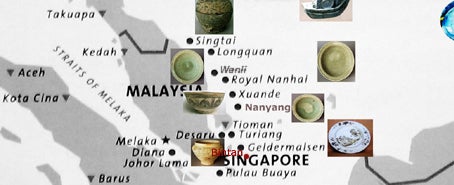
At a time when England was occupied with the War of the Roses and Christopher Columbus was planning his trip of discovery to the New World, a Siamese junk plied the waters off the east coast of the Malaysian peninsula, transporting a heavy load of of green and brown glazed Celadon ceramic to the southern port of Tuban in Eastern Java. The ill-fated vessel came into trouble on route, most likely during one of the violent monsoonal storms common to the South China Sea. Her unusual length and extremely heavy load may have contributed to her difficulties, causing her to spring a leak and sink quickly to the seabed. Sten Sjöstrand named the Royal Nanhai in honor of the 15th century Chinese name for the South China Sea: Nanhai.
The Royal Nanhai shipwreck was discovered in 1992 at a depth of 46 meters, 40 nautical miles offshore from Kuantan, West Malaysia and was excavated until September 1998. The vessel appears to be 28m long and 7m wide, and is of a typical South China Sea design. This type of vessel, a hybrid that combines Chinese and Southeast Asian elements, has hull planks joined by wooden dowels, and transversal bulkheads. Its cargo included a final recovery count of 20,973 ceramics, most of which were Sisatchanalai celadon, along with Singburi storage jars and some Chinese brown ware. Four Chinese blue and white bowels and two Vietnamese blue and white covered boxes were found hidden below floorboards. The cargo also included iron and tin.
The site was found littered with celadon from the Sisatchanalai kilns in Thailand and a few Chinese celadon plates. The archeological excavations of the site provided many new data. Museums and antique collectors appreciated some of the finest 15th century celadon wares ever seen in the market.
The recovered celadon ware from the Royal Nanhai includes numbers of rare Chinese celadon plates. The largest portion is celadon in various shapes from the Sisatchanalai kilns. Eighty percent of the pottery was severely deteriorated.
Seven pieces of blue and white pottery from China and Vietnam were also discovered, in a secret compartment below all other cargo. Blue and white ceramics are thought to have been especially scarce in the period AD. 1370-1440. The presence of these blue and white pieces, and the style of their painted designs, suggests a date for the wreck of mid-15th century. This date is supported by a carbon-14 date corresponding to AD.1400 +/- 70-years.
The details of the celadon manufacture and its designs were able to locate precisely the kiln sites in Sisatchanalai, northern Thailand in which the Royal Nanhai (and the Nanyang) shipwreck celadon ware was made around AD. 1380-1460. Other kilns, located in Sukhothai, are assigned to the fish and flower plates found on the Turiang and Longquan shipwrecks.
Of the recoverable twenty percent (ca. 4200 pieces), 2,619 pieces were donated to the National Museum in Kuala Lumpur and a further representative selection was given to the Pekan Museum in Pahang State and the Malacca Museum Corporation. Their unquestionable authenticity and precise dating provide a level of provenance that is rarely seen today in the Southeast Asian antique pottery market, and several international museums, including the Victoria & Albert Museum in London, now display pieces from the Royal Nanhai as reference material.

